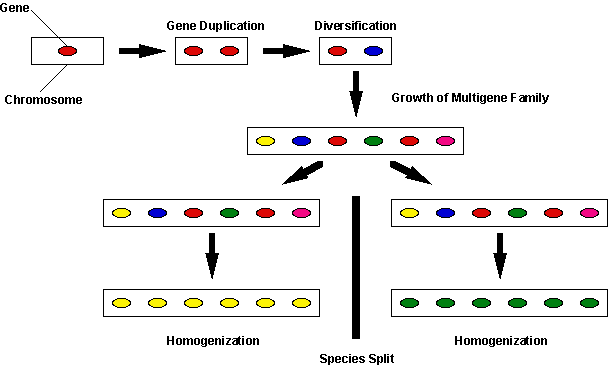
| MadSci Network: Evolution |
The theory of molecular drive (also known as 'concerted evolution') was first proposed in 1982 by Gabriel A. Dover to explain observed homogeneity of repeated genes in a particular multi-gene family within a given species. It had been noticed that genes in some multi-gene families were often more closely related to one-another in a given species than to their homologous counterparts in related species, as shown in the figure below.

As you can see at the bottom of the figure, each gene in the multi-gene family is more closely related to genes on the same chromosome than to homologous genes in the sister species (across the species split). While this is not always the case (c.f. MHC genes), it has been observed many times (e.g. tandemly repeated rRNA genes).
Molecular drive theory holds that unequal crossover and other such non- reciprocal exchanges (Dover calls the entire set of forces 'mechanisms of molecular turnover') between homologous (and sometimes non-homologous) chromosomes spread a particular variant of a gene from one chromosome to the next, and that sexual reproduction spreads the variant gene through the species until the variant gene reaches fixation. While a similar process might occur in which a multi-gene family on a particular chromosome first becomes homogenized and subsequently spread to fixation through a population via genetic drift, this process is necessarily slow, while the process of molecular drive is relatively rapid in comparison. In addition, the processes of multi-gene homogenization and chromosomal fixation occur concomitantly under molecular drive. Because the processes underlying molecular drive are stochastic and restricted to a particular species, the specific variant which becomes fixed in sister populations can vary.
Given that molecular drive is operating in a given species, Dover concludes that there "are circumstances in which the unusual concerted pattern of fixation permits the establishment of biological novelty and species discontinuities in a manner not predicted by the classical genetics of natural selection and genetic drift."
Here are some references that you can take a look at for more information.
Dover Gabriel A. Molecular drive A cohesive mode of species evolution.
(1982) Nature 299: 111-7
Dover GA, Linares AR, Bowen T, Hancock JM. Detection and quantification of
concerted evolution and molecular drive. (1993) Methods in Enzymology
224:525-41
Dover G. Concerted evolution, molecular drive and natural selection. (1994)
Current Biology Dec 4: 1165-6
Bowen T, Dover GA. PCR amplification of intergenic spacers in the ribosomal
DNA of Drosophila melanogaster reveals high levels of turnover in length and
copy-number of spacers in geographically separated populations. (1995)
Molecular Ecology 4: 419-27
Try the links in the MadSci Library for more information on Evolution.
MadSci Home | Information |
Search |
Random Knowledge Generator |
MadSci Archives |
Mad Library | MAD Labs |
MAD FAQs |
Ask a ? |
Join Us! |
Help Support MadSci
MadSci Network,
webadmin@www.madsci.org
© 1995-2001. All rights reserved.